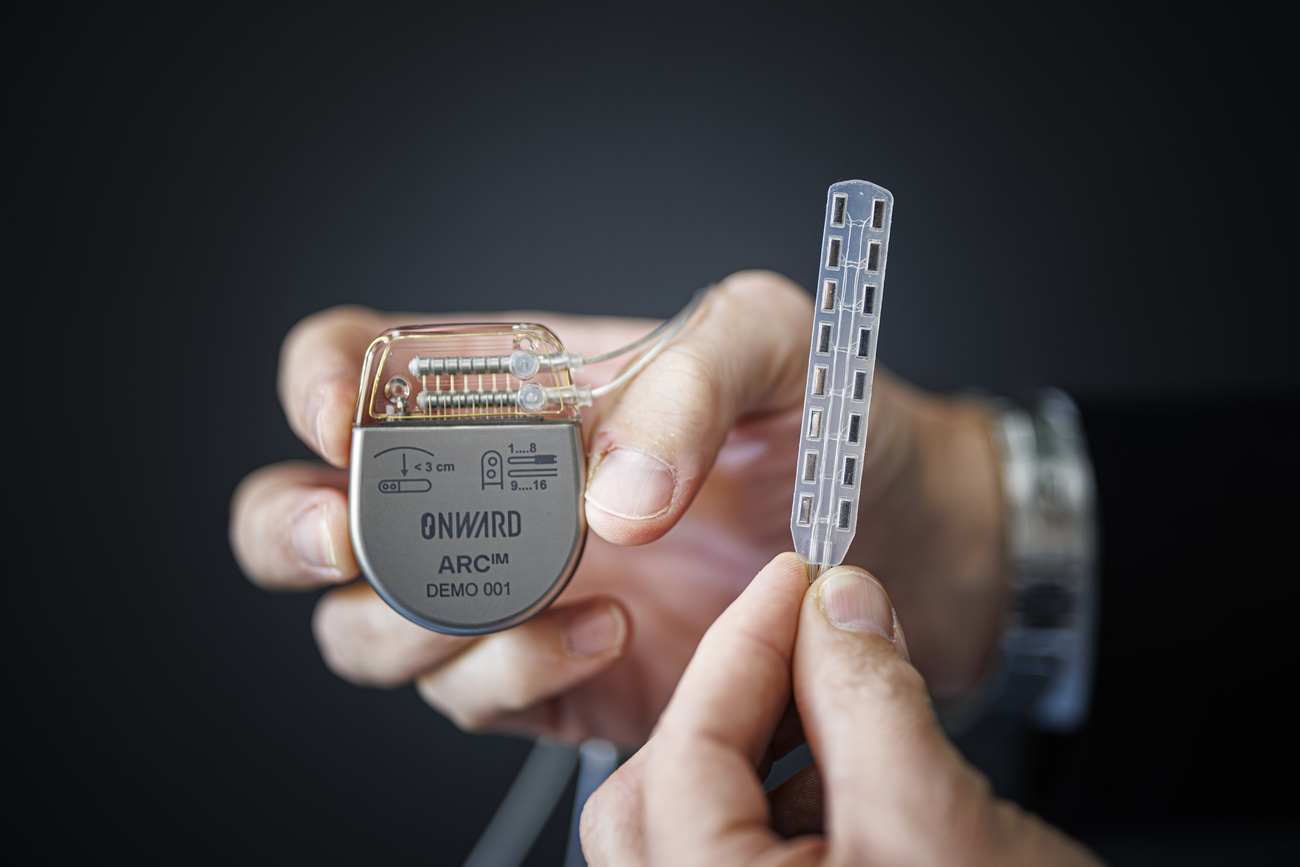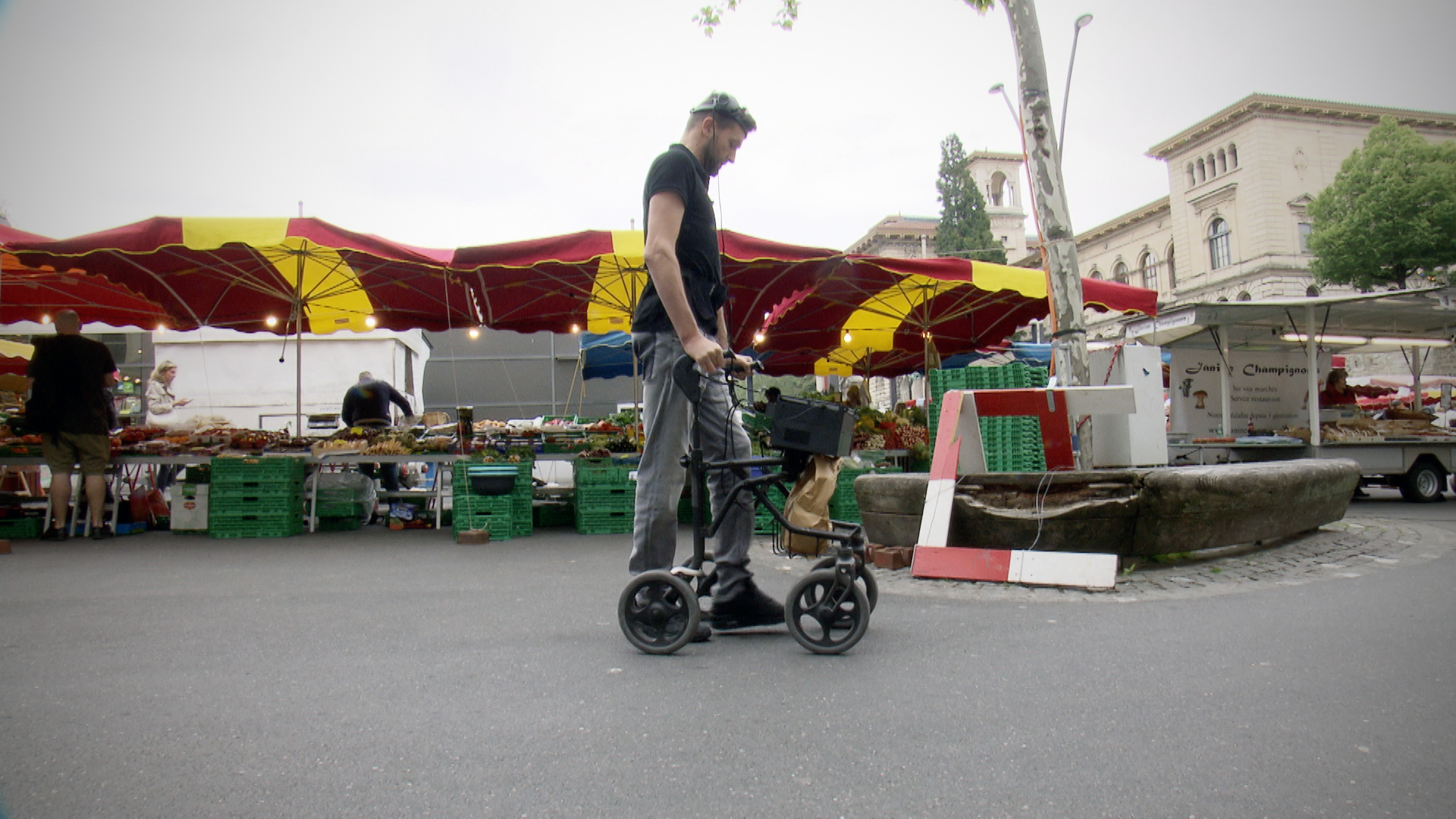
Swiss-designed prosthetic helps Parkinson’s patient walk again

Neuroscientists from Lausanne and France presented a neuroprosthetic on Monday that corrects the mobility disorders associated with Parkinson's disease. Once confined to his home, the first patient to receive the implant is now able to walk confidently and without falling.
Walking disorders occur in around 90% of people with advanced Parkinson’s disease. Up to now, there have been no treatments available in the majority of cases.
Marc, who is in his 60s, has been living with Parkinson’s disease since 1996. Dopamine and then deep brain stimulation, which he underwent in 2004, helped treat his tremors and stiffness. But he also developed severe walking difficulties.

More
Swiss research helps paralysed man walk again using implants that read brainwaves
“I could hardly walk without frequent falls, several times a day,” explained Marc, the subject of the study, at an online press briefing organized by the Lausanne University Hospital CHUV and the Swiss Federal Institute of Technology in Lausanne (EPFL). He also suffered from “freezing”, a blockage that caused him to be stopped in front of an obstacle, such as an elevator shaft, and be unable to move.
Electrical stimulation
“The idea of developing a neuroprosthetic that electrically stimulates the spinal cord to harmonise gait and correct locomotor disorders in Parkinson’s patients is the fruit of several years’ research,” explained Grégoire Courtine, Professor of Neuroscience at EPFL, CHUV and the University of Lausanne.
Unlike conventional treatments which target brain regions directly affected by the loss of dopamine-producing neurons, this neuroprosthetic targets the area of the spinal cord responsible for activating leg muscles during walking. An area which is not directly affected by the disease.
With Erwan Bezard, a neuroscientist from France’s Inserm and the University of Bordeaux, Courtine and Lausanne-based neurosurgeon Jocelyne Bloch operated on the first patient in 2021. Marc, from Bordeaux, was fitted with the neuroprosthetic consisting of a field of electrodes placed against the area of his spinal cord that controls walking, and a pacemaker implanted under the skin of his abdomen.
Thanks to targeted programming of the spinal cord stimuli, which adapt in real time to his movements, Marc’s walking difficulties quickly disappeared. After a few weeks’ rehabilitation with the neuroprosthetic, he was able to walk almost normally again.
The effect on walking was almost immediate, according to the scientists. As for the “freezing”, it has completely disappeared, said Marc. The patient also has connected shoes that send information about his walking, and a watch to initiate stimulation, all linked to a wireless computer.
Today, he uses his neuroprosthetic for around eight hours a day, switching it off only when he’s sitting for a long period or when he’s asleep. “Even the stairs don’t scare me anymore. Every Sunday I go to the lakeside, and walk about six kilometers. I love it. It’s saved my life,” he said.
Large-scale deployment
At this stage, this therapeutic concept has demonstrated its effectiveness in a single person, with an implant that still needs to be optimised for large-scale deployment, indicated the authors of this research published in the journal Nature Medicine.
There are still some limitations. Courtine points out that neuroprosthetic requires good cognitive skills on the part of the patient, as it amplifies movements. It’s a kind of “managing an avatar”. “You have to concentrate when the stimulation is triggered,” confirmed Marc.
Scientists are currently working on developing a commercial version of the neuroprosthetic. A study on six additional patients will begin next year, announced Bloch. It is financed to the tune of CHF1 million by the Michael J. Fox Foundation.
This news story has been written and carefully fact-checked by an external editorial team. At SWI swissinfo.ch we select the most relevant news for an international audience and use automatic translation tools such as DeepL to translate it into English. Providing you with automatically translated news gives us the time to write more in-depth articles. You can find them here.
If you want to know more about how we work, have a look here, and if you have feedback on this news story please write to english@swissinfo.ch.

In compliance with the JTI standards
More: SWI swissinfo.ch certified by the Journalism Trust Initiative




























You can find an overview of ongoing debates with our journalists here . Please join us!
If you want to start a conversation about a topic raised in this article or want to report factual errors, email us at english@swissinfo.ch.